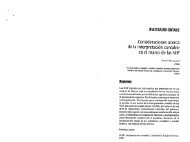HERNANDEZ_Metodologia de la investigación 5ta Edición
You also want an ePaper? Increase the reach of your titles
YUMPU automatically turns print PDFs into web optimized ePapers that Google loves.
610<br />
Índice analítico<br />
Inmersión en el campo<br />
inicial, 374<br />
total, 374<br />
Innovación, 63, 68<br />
Instrumentación, 130, 138, 140<br />
Instrumentos <strong>de</strong> medición, 199, 200, 201-269<br />
procedimiento para construir, 209-211<br />
tránsito <strong>de</strong> <strong>la</strong> variable al ítem, 211-212<br />
codificación, 213-214<br />
niveles <strong>de</strong> medición, 214-217<br />
requisitos, 200-207<br />
confiabilidad, 207, véase también Confiabilidad<br />
objetividad, 206-208<br />
vali<strong>de</strong>z, 200-204, véase también Vali<strong>de</strong>z<br />
cómo se codifican <strong>la</strong>s respuestas <strong>de</strong> un,<br />
262-269<br />
los valores perdidos y su codificación,<br />
262-263<br />
codificación física, 265-266<br />
e<strong>la</strong>borar el libro o documento <strong>de</strong> códigos,<br />
264-265<br />
establecer códigos, 263-264<br />
generación <strong>de</strong> archivo, 266<br />
tipos, 217-244<br />
análisis <strong>de</strong> contenido, 260<br />
cuestionario, 217-244<br />
esca<strong>la</strong>s para medir <strong>la</strong>s actitu<strong>de</strong>s, 244-260<br />
observación, 260-261<br />
pruebas estandarizadas e inventarios, 261<br />
datos secundarios, 261-262<br />
instrumentos mecánicos o electrónicos,<br />
262<br />
instrumentos propios <strong>de</strong> cada disciplina,<br />
262<br />
Internet, 26-27, 29, 38, 53, 56-57, 72<br />
Investigación-acción participativa o<br />
cooperativa, 510<br />
Investigación<br />
causal prospectiva, 157<br />
corre<strong>la</strong>cional. Véase Estudios corre<strong>la</strong>cionales<br />
<strong>de</strong>scriptiva. Véase Estudios <strong>de</strong>scriptivos<br />
explicativa. Véase Estudios explicativos<br />
exploratoria. Véase Estudios exploratorios<br />
longitudinal, 158-161<br />
transeccional o transversal, 151-158<br />
Investigación cualitativa, 4, 8-11, 13, 16-17,<br />
361-542<br />
anotaciones o notas <strong>de</strong> campo, 376-380<br />
<strong>de</strong> <strong>la</strong> observación directa, 377<br />
interpretativas, 377-378<br />
temáticas, 378<br />
<strong>de</strong> <strong>la</strong> reactividad <strong>de</strong> los participantes,<br />
379-380<br />
bitácora <strong>de</strong> campo, 380-383<br />
características, 7-10<br />
cinco fases, 4<br />
como estudios, 10<br />
contro<strong>la</strong>dores <strong>de</strong> ingreso a un lugar. Véase<br />
Gatekeepers<br />
<strong>de</strong>finición, 7<br />
<strong>de</strong>tractores, 17<br />
diferencias entre los enfoques, 10<br />
diseños <strong>de</strong>l proceso <strong>de</strong>, 492-516<br />
<strong>de</strong> teoría fundamentada, 492-501<br />
diseño sistemático, 493<br />
codificación abierta, 494<br />
codificación axial, 494<br />
codificación selectiva, 486-497<br />
diseño emergente, 497-498<br />
etnográficos, 501-504<br />
narrativos, 504-509<br />
<strong>de</strong> <strong>investigación</strong>-acción, 509-515<br />
fenomenológicos, 515-516<br />
ejemplos <strong>de</strong> investigaciones, 18-19<br />
esencia <strong>de</strong> <strong>la</strong>, 364<br />
explorar el contexto, 371<br />
gatekeepers, 372<br />
hipótesis <strong>de</strong> trabajo, 370-371<br />
holística, 9<br />
inmersión en el contexto, ambiente<br />
o campo, 382<br />
total, 374<br />
introspección con grupos, 9<br />
justificación y viabilidad <strong>de</strong>l estudio,<br />
364-367<br />
ingreso en el ambiente (campo), 371-374<br />
explorar el contexto, 371<br />
interpretativo, 7<br />
literatura, 369-370<br />
naturalista, 7n<br />
muestreo en <strong>la</strong>, 394-402<br />
muestra, 394<br />
inicial, 394-396<br />
reformu<strong>la</strong>ción <strong>de</strong> <strong>la</strong>, 395<br />
<strong>de</strong> participantes voluntarios, 396-397<br />
<strong>de</strong> expertos, 397<br />
<strong>de</strong> casos-tipo, 397<br />
por cuotas, 397<br />
composición y tamaño <strong>de</strong> <strong>la</strong>, 400<br />
muestras dirigidas, 401<br />
muestras más bien orientadas hacia <strong>la</strong><br />
<strong>investigación</strong> cualitativa,<br />
397-401<br />
diversas o <strong>de</strong> máxima variación,<br />
397-398<br />
homogéneas, 398<br />
en ca<strong>de</strong>na o por re<strong>de</strong>s, 398<br />
<strong>de</strong> casos extremos, 399<br />
por oportunidad, 399<br />
teóricas o conceptuales, 399-400<br />
confirmativas, 400<br />
<strong>de</strong> casos sumamente importantes, 400<br />
observación, 374-375<br />
observación no estructurada, 9<br />
participantes, 379<br />
p<strong>la</strong>nteamiento <strong>de</strong>l problema, 364-369<br />
contexto o ambiente, 366<br />
exploración <strong>de</strong> <strong>de</strong>ficiencias, 364-369<br />
objetivos, 364-368<br />
www.FreeLibros.com<br />
preguntas <strong>de</strong> <strong>investigación</strong>, 364-368<br />
justificación o viabilidad, 364-368<br />
reporte <strong>de</strong> resultados <strong>de</strong> <strong>la</strong>, 524-538<br />
características y recomendaciones,<br />
524-525<br />
estructura <strong>de</strong>l, 525-537<br />
revisión y evaluación <strong>de</strong>l, 537<br />
cómo citar referencias en un, 538<br />
reporte <strong>de</strong>l diseño <strong>de</strong> <strong>investigación</strong>-acción,<br />
537<br />
Investigación(es) cuantitativa(s), 4-7, 37-275<br />
alcances, 78-79<br />
exploratorio, 79-80<br />
<strong>de</strong>scriptivo, 80-81<br />
corre<strong>la</strong>cional, 81-83<br />
explicativo, 83-84<br />
características <strong>de</strong> una hipótesis, 95-96<br />
<strong>de</strong>limitar un problema, 36, 42<br />
diseño <strong>de</strong> <strong>investigación</strong>, 120<br />
diseños experimentales, 121-149<br />
ejemplo <strong>de</strong> una, 18<br />
evaluación <strong>de</strong> <strong>la</strong>s <strong>de</strong>ficiencias <strong>de</strong>l<br />
problema, 36<br />
formu<strong>la</strong>ción <strong>de</strong> hipótesis, 94<br />
fuentes <strong>de</strong> hipótesis, 94<br />
fuente[s) <strong>de</strong> invalidación externa,<br />
144-146<br />
<strong>de</strong>scripciones insuficientes, 145<br />
experimentador, 146<br />
imposibilidad <strong>de</strong> replicar los<br />
tratamientos, 145<br />
interacción <strong>de</strong> <strong>la</strong>s pruebas, 144<br />
interacción entre <strong>la</strong> historia, 146<br />
interacción entre los errores <strong>de</strong><br />
selección, 145<br />
novedad e interrupción, 146<br />
tratamientos experimentales, 145<br />
tratamientos múltiples, 145<br />
variable <strong>de</strong>pendiente, 146<br />
fuente[s) <strong>de</strong> invalidación interna, 129-130<br />
experimentador como, 130<br />
sujetos participantes como, 130-131<br />
instrumentos <strong>de</strong> medición, 199, 200,<br />
201-269<br />
procedimiento para construir, 209-211<br />
requisitos, 200-207<br />
respuestas, cómo se codifican, 262-269<br />
tipos, 217-244<br />
justificación <strong>de</strong> <strong>la</strong>, 36, 39<br />
lógica <strong>de</strong>ductiva, 11<br />
no experimental, 149-164<br />
perspectiva, 79<br />
p<strong>la</strong>ntear el problema <strong>de</strong>,<br />
<strong>de</strong>finición, 36<br />
criterios para, 36<br />
elementos,<br />
objetivos <strong>de</strong> <strong>la</strong> <strong>investigación</strong>, 36<br />
preguntas <strong>de</strong> <strong>investigación</strong>, 37-39<br />
justificación <strong>de</strong> <strong>la</strong> <strong>investigación</strong>, 41<br />
viabilidad <strong>de</strong> <strong>la</strong> <strong>investigación</strong>, 41



